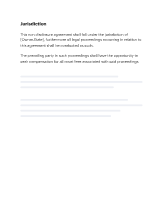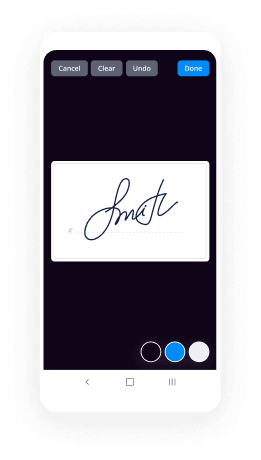Fill and Sign the Texas Southern District Bankruptcy Guide and Forms Package for Chapters 7 or 13 Texas

Helpful tips on setting up your ‘Texas Southern District Bankruptcy Guide And Forms Package For Chapters 7 Or 13 Texas’ online
Are you fed up with the inconvenience of dealing with paperwork? Look no further than airSlate SignNow, the premier eSignature solution for individuals and businesses. Wave farewell to the monotonous task of printing and scanning documents. With airSlate SignNow, you can effortlessly finish and sign documents online. Utilize the robust features integrated into this intuitive and cost-effective platform and transform your method of document management. Whether you need to approve forms or gather electronic signatures, airSlate SignNow simplifies the process, requiring just a few clicks.
Adhere to this comprehensive guide:
- Sign in to your account or enroll for a complimentary trial with our service.
- Click +Create to upload a file from your device, cloud storage, or our template collection.
- Access your ‘Texas Southern District Bankruptcy Guide And Forms Package For Chapters 7 Or 13 Texas’ in the editor.
- Select Me (Fill Out Now) to set up the document on your side.
- Include and assign fillable fields for others (if necessary).
- Continue with the Send Invite options to solicit eSignatures from others.
- Save, print your copy, or convert it into a reusable template.
No need to worry if you need to collaborate with your colleagues on your Texas Southern District Bankruptcy Guide And Forms Package For Chapters 7 Or 13 Texas or send it for notarization—our platform offers everything you need to complete such tasks. Create an account with airSlate SignNow today and take your document management to the next level!
FAQs
-
What is the Texas Southern District Bankruptcy Guide And Forms Package For Chapters 7 Or 13 Texas?
The Texas Southern District Bankruptcy Guide And Forms Package For Chapters 7 Or 13 Texas is a comprehensive resource designed to assist individuals and businesses in navigating the bankruptcy process in Texas. This package includes essential forms, instructions, and guidelines tailored to the Southern District's requirements, ensuring compliance and ease of use.
-
How much does the Texas Southern District Bankruptcy Guide And Forms Package For Chapters 7 Or 13 Texas cost?
The pricing for the Texas Southern District Bankruptcy Guide And Forms Package For Chapters 7 Or 13 Texas is competitive and designed to provide excellent value. You can choose from various pricing options depending on your specific needs, making it an affordable choice for anyone seeking bankruptcy assistance.
-
What forms are included in the Texas Southern District Bankruptcy Guide And Forms Package For Chapters 7 Or 13 Texas?
The Texas Southern District Bankruptcy Guide And Forms Package For Chapters 7 Or 13 Texas includes all necessary forms required for filing, such as the petition, schedules, and statement of financial affairs. Each form is updated to reflect the latest legal requirements and is designed for straightforward completion.
-
How can the Texas Southern District Bankruptcy Guide And Forms Package For Chapters 7 Or 13 Texas help me?
This guide is designed to simplify the bankruptcy process, helping you understand your options under Chapters 7 or 13. By utilizing the Texas Southern District Bankruptcy Guide And Forms Package For Chapters 7 Or 13 Texas, you can save time, reduce stress, and ensure that your paperwork is completed accurately, increasing your chances of a successful filing.
-
Is the Texas Southern District Bankruptcy Guide And Forms Package For Chapters 7 Or 13 Texas suitable for both individuals and businesses?
Yes, the Texas Southern District Bankruptcy Guide And Forms Package For Chapters 7 Or 13 Texas is suitable for both individuals and businesses facing bankruptcy. It provides essential tools and information tailored for various scenarios, making it a versatile option for different users.
-
Are there any integrations available with the Texas Southern District Bankruptcy Guide And Forms Package For Chapters 7 Or 13 Texas?
The Texas Southern District Bankruptcy Guide And Forms Package For Chapters 7 Or 13 Texas is designed to work seamlessly with various document management systems and e-signature solutions, including airSlate SignNow. This integration streamlines the filing process, allowing users to manage their documents efficiently.
-
How often is the Texas Southern District Bankruptcy Guide And Forms Package For Chapters 7 Or 13 Texas updated?
The Texas Southern District Bankruptcy Guide And Forms Package For Chapters 7 Or 13 Texas is regularly updated to reflect the latest changes in bankruptcy law and district court requirements. This ensures that users have access to the most current information and forms necessary for a successful filing.
Related searches to texas southern district bankruptcy guide and forms package for chapters 7 or 13 texas
The best way to complete and sign your types of bankruptcies in texas
Find out other texas southern district bankruptcy guide and forms package for chapters 7 or 13 texas
- Close deals faster
- Improve productivity
- Delight customers
- Increase revenue
- Save time & money
- Reduce payment cycles















